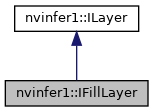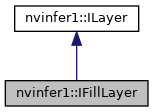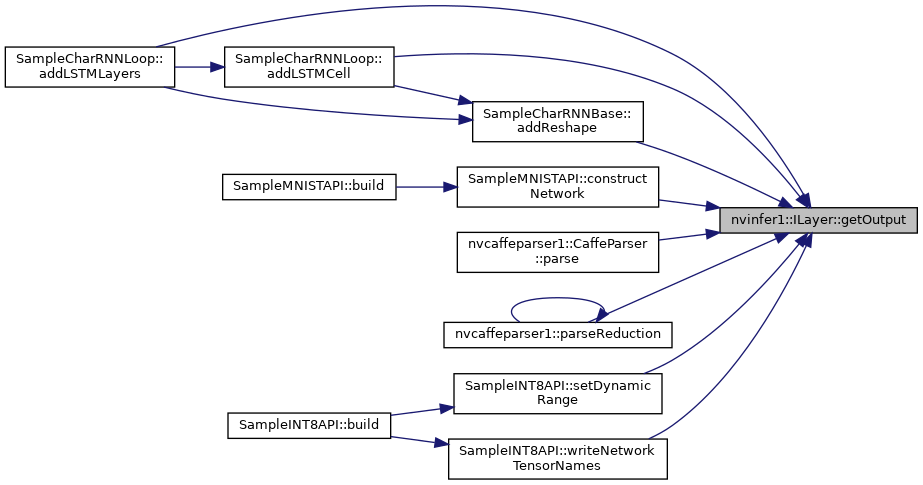Generate an output tensor with specified mode. More...


Public Member Functions | |
| virtual void | setDimensions (Dims dimensions) noexcept=0 |
| Set the output tensor's dimensions. More... | |
| virtual Dims | getDimensions () const noexcept=0 |
| Get the output tensor's dimensions. More... | |
| virtual void | setOperation (FillOperation op) noexcept=0 |
| Set the fill operation for the layer. More... | |
| virtual FillOperation | getOperation () const noexcept=0 |
| Get the fill operation for the layer. More... | |
| virtual void | setAlpha (double alpha) noexcept=0 |
| Set the alpha parameter. More... | |
| virtual double | getAlpha () const noexcept=0 |
| Get the value of alpha parameter. More... | |
| virtual void | setBeta (double beta) noexcept=0 |
| Set the beta parameter. More... | |
| virtual double | getBeta () const noexcept=0 |
| Get the value of beta parameter. More... | |
| void | setInput (int32_t index, ITensor &tensor)=0 |
| replace an input of this layer with a specific tensor. More... | |
| virtual LayerType | getType () const =0 |
| Return the type of a layer. More... | |
| virtual void | setName (const char *name)=0 |
| Set the name of a layer. More... | |
| virtual const char * | getName () const =0 |
| Return the name of a layer. More... | |
| virtual int32_t | getNbInputs () const =0 |
| Get the number of inputs of a layer. More... | |
| virtual ITensor * | getInput (int32_t index) const =0 |
| Get the layer input corresponding to the given index. More... | |
| virtual int32_t | getNbOutputs () const =0 |
| Get the number of outputs of a layer. More... | |
| virtual ITensor * | getOutput (int32_t index) const =0 |
| Get the layer output corresponding to the given index. More... | |
| virtual void | setPrecision (DataType dataType)=0 |
| Set the computational precision of this layer. More... | |
| virtual DataType | getPrecision () const =0 |
| get the computational precision of this layer More... | |
| virtual bool | precisionIsSet () const =0 |
| whether the computational precision has been set for this layer More... | |
| virtual void | resetPrecision ()=0 |
| reset the computational precision for this layer More... | |
| virtual void | setOutputType (int32_t index, DataType dataType)=0 |
| Set the output type of this layer. More... | |
| virtual DataType | getOutputType (int32_t index) const =0 |
| get the output type of this layer More... | |
| virtual bool | outputTypeIsSet (int32_t index) const =0 |
| whether the output type has been set for this layer More... | |
| virtual void | resetOutputType (int32_t index)=0 |
| reset the output type for this layer More... | |
Protected Member Functions | |
| virtual | ~IFillLayer () |
Generate an output tensor with specified mode.
The fill layer has two variants, static and dynamic. Static fill specifies its parameters at layer creation time via Dims and the get/set accessor functions of the IFillLayer. Dynamic fill specifies one or more of its parameters as ITensors, by using ILayer::setTensor to add a corresponding input. The corresponding static parameter is used if an input is missing or null.
The shape of the output is specified by the parameter Dimension, or if non-null and present, the first input, which must be a 1D Int32 shape tensor. Thus an application can determine if the IFillLayer has a dynamic output shape based on whether it has a non-null first input.
Alpha and Beta are treated differently based on the Fill Operation specified. See details in IFillLayer::setAlpha(), IFillLayer::setBeta(), and IFillLayer::setInput().
|
inlineprotectedvirtual |
|
pure virtualnoexcept |
Set the output tensor's dimensions.
| dimensions | The output tensor's dimensions. |
If the first input is set, it is reset to null.
|
pure virtualnoexcept |
Get the output tensor's dimensions.
If the first input is present and non-null, this function returns a Dims with nbDims = -1.
|
pure virtualnoexcept |
Set the fill operation for the layer.
|
pure virtualnoexcept |
Get the fill operation for the layer.
|
pure virtualnoexcept |
Set the alpha parameter.
| alpha | has different meanings for each operator: |
Operation | Usage kLINSPACE | the start value; kRANDOMUNIFORM | the minimum value;
If the second input is set, it is reset to null.
|
pure virtualnoexcept |
|
pure virtualnoexcept |
Set the beta parameter.
| beta | has different meanings for each operator: |
Operation | Usage kLINSPACE | the delta value; kRANDOMUNIFORM | the maximal value;
If the third input is set, it is reset to null.
|
pure virtualnoexcept |
|
pure virtual |
replace an input of this layer with a specific tensor.
| index | the index of the input to set. |
| tensor | the new input tensor |
Indices for kLINSPACE are described as:
Indices for kRANDOM_UNIFORM are described as:
Using the corresponding setter resets the input to null.
If either inputs 1 or 2, is non-null, then both must be non-null and have the same data type.
If this function is called for an index greater or equal to getNbInputs(), then afterwards getNbInputs() returns index + 1, and any missing intervening inputs are set to null.
Implements nvinfer1::ILayer.
|
pure virtualinherited |
Return the type of a layer.
|
pure virtualinherited |
Set the name of a layer.
This method copies the name string.

|
pure virtualinherited |
|
pure virtualinherited |
Get the number of inputs of a layer.
|
pure virtualinherited |
Get the layer input corresponding to the given index.
| index | The index of the input tensor. |
|
pure virtualinherited |
Get the number of outputs of a layer.

|
pure virtualinherited |
Get the layer output corresponding to the given index.

|
pure virtualinherited |
Set the computational precision of this layer.
Setting the precision allows TensorRT to choose implementation which run at this computational precision. Layer input type would also get inferred from layer computational precision. TensorRT could still choose a non-conforming fastest implementation ignoring set layer precision. Use BuilderFlag::kSTRICT_TYPES to force choose implementations with requested precision. In case no implementation is found with requested precision, TensorRT would choose available fastest implementation. If precision is not set, TensorRT will select the layer computational precision and layer input type based on performance considerations and the flags specified to the builder.
| precision | the computational precision. |
|
pure virtualinherited |
get the computational precision of this layer
|
pure virtualinherited |
whether the computational precision has been set for this layer
|
pure virtualinherited |
reset the computational precision for this layer
|
pure virtualinherited |
Set the output type of this layer.
Setting the output type constrains TensorRT to choose implementations which generate output data with the given type. If it is not set, TensorRT will select output type based on layer computational precision. TensorRT could still choose non-conforming output type based on fastest implementation. Use BuilderFlag::kSTRICT_TYPES to force choose requested output type. In case layer precision is not specified, output type would depend on chosen implementation based on performance considerations and the flags specified to the builder.
This method cannot be used to set the data type of the second output tensor of the TopK layer. The data type of the second output tensor of the topK layer is always Int32. Also the output type of all layers that are shape operations must be DataType::kINT32, and all attempts to set the output type to some other data type will be ignored except for issuing an error message.
Note that the layer output type is generally not identical to the data type of the output tensor, as TensorRT may insert implicit reformatting operations to convert the former to the latter. Calling layer->setOutputType(i, type) has no effect on the data type of the i-th output tensor of layer, and users need to call layer->getOutput(i)->setType(type) to change the tensor data type. This is particularly relevant if the tensor is marked as a network output, since only setType() [but not setOutputType()] will affect the data representation in the corresponding output binding.
| index | the index of the output to set |
| dataType | the type of the output |
|
pure virtualinherited |
get the output type of this layer
| index | the index of the output |
|
pure virtualinherited |
whether the output type has been set for this layer
| index | the index of the output |
|
pure virtualinherited |
reset the output type for this layer
| index | the index of the output |